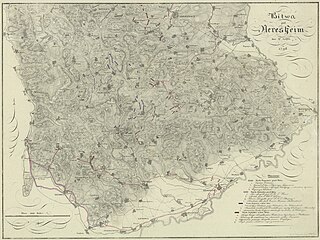
The Battle of Neresheim was fought by the Republican French army under Jean Victor Marie Moreau against the army of the Habsburg monarchy of Archduke Charles, Duke of Teschen. Pursued by Moreau's Army of Rhin-et-Moselle, Charles launched an attack against the French. While the Austrian left wing saw some success, the battle degenerated into a stalemate and the archduke withdrew further into the Electorate of Bavaria. Neresheim is located in the state of Baden-Württemberg in Germany a distance of 57 kilometres (35 mi) northeast of Ulm. The action took place during the War of the First Coalition, part of a larger conflict called the French Revolutionary Wars.
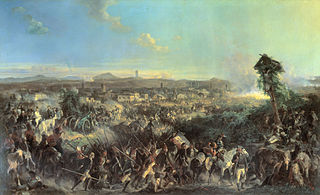
The Battle of Novi saw a combined army of the Habsburg monarchy and Imperial Russians under Field Marshal Alexander Suvorov attack a Republican French army under General Barthélemy Catherine Joubert. As soon as Joubert fell during the battle, Jean Victor Marie Moreau immediately took overall command of the French forces. After a prolonged and bloody struggle, the Austro-Russians broke through the French defenses and drove their enemies into a disorderly retreat, while French division commanders Catherine-Dominique de Pérignon and Emmanuel Grouchy were captured. Novi Ligure is in the province of Piedmont in Northern Italy a distance of 58 kilometres (36 mi) north of Genoa. The battle occurred during the War of the Second Coalition which was part of the French Revolutionary Wars.

The Battle of Tourcoing saw a Republican French army directed by General of Division Joseph Souham defend against an attack by a Coalition army led by Emperor Francis II and Austrian Prince Josias of Saxe-Coburg-Saalfeld. The French army was temporarily led by Souham in the absence of its normal commander Jean-Charles Pichegru. Threatened with encirclement, Souham and division commanders Jean Victor Marie Moreau and Jacques Philippe Bonnaud improvised a counterattack which defeated the Coalition's widely separated and poorly coordinated columns. The War of the First Coalition action was fought near the town of Tourcoing, north of Lille in northeastern France.

The Battle of Minden was a major engagement during the Seven Years' War, fought on 1 August 1759. An Anglo-German army under the overall command of Prussian Field Marshal Ferdinand of Brunswick defeated a French army commanded by Marshal of France, Marquis de Contades. Two years previously, the French had launched a successful invasion of Hanover and attempted to impose an unpopular treaty of peace upon the allied nations of Britain, Hanover and Prussia. After a Prussian victory at Rossbach, and under pressure from Frederick the Great and William Pitt, King George II disavowed the treaty. In 1758, the allies launched a counter-offensive against the French and Saxon forces and drove them back across the Rhine.

The Battle of Sehested was fought between Danish and Russian-Prussian-British troops at Sehested on 10 December 1813 during the War of the Sixth Coalition. The Danish Auxiliary Corps, which fought on the side of the French defeated the coalition forces commanded by Major General Ludwig von Wallmoden-Gimborn.

The Combat of the Côa was a military engagement that occurred during the Peninsular War period of the Napoleonic Wars. It took place in the valley of the Côa River and it was the first significant battle for the new army of 65,000 men controlled by Marshal André Masséna, as the French prepared for their third invasion of Portugal.
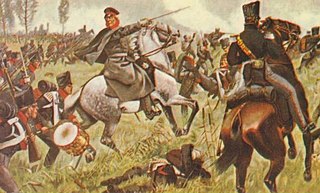
The Battle of Wartenburg took place on 3 October 1813 between the French IV Corps commanded by General Henri Gatien Bertrand and the Allied Army of Silesia, principally the I Corps of General Ludwig von Yorck. The battle allowed the Army of Silesia to cross the Elbe, ultimately leading to the Battle of Leipzig.

The Battle of Boxtel was fought in the Duchy of Brabant on 14–15 September 1794, during the War of the First Coalition. It was part of the Flanders Campaign of 1793–94 in which British, Dutch and Austrian troops had attempted to launch an invasion of France through Flanders. It is often remembered as being the debut action of Arthur Wellesley, who later became the 1st Duke of Wellington.
The Battle of Emsdorf was fought on 16 July 1760 during the Seven Years' War at Emsdorf in present-day Hesse, Germany, between forces of British, Hanoverian and Hessian troops under the Prince of Hesse-Kassel against German troops in French service under Marechal de Camp von Glaubitz. It was part of the campaign to disrupt the French line of communications by capturing Marburg, a French supply depot.
This is an order of battle of the French and German Armies at the beginning of the Franco-Prussian War in 1870.
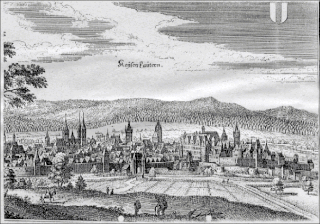
The Battle of Kaiserslautern saw a Coalition army under Charles William Ferdinand, Duke of Brunswick-Wolfenbüttel oppose a Republican French army led by Lazare Hoche. Three days of conflict resulted in a victory by the Prussians and their Electoral Saxon allies as they turned back repeated French attacks. The War of the First Coalition combat was fought near the city of Kaiserslautern in the modern-day state of Rhineland-Palatinate, Germany, which is located about 60 kilometres (37 mi) west of Mannheim.
In the Battle of Villers-en-Cauchies, fought on 24 April 1794, a small Anglo-Austrian cavalry force routed a vastly more numerous French division during the Flanders Campaign of the French Revolutionary Wars. Villers-en-Cauchies is 15 km south of Valenciennes.

The Battle of Corbach, or Korbach, a Hanseatic town of Waldeck-Frankenberg in northern Hesse, Germany, was fought on 10 July 1760 during the Seven Years' War. Corbach was the first battle of the campaign of 1760 and was a victory for the French over the Hanoverians, the British and their allies.

In the First Battle of Wissembourg an Allied army commanded by Dagobert Sigmund von Wurmser attacked the French Army of the Rhine under Jean Pascal Carlenc. After an ineffectual resistance, the French army abandoned its fortified line behind the Lauter River and retreated toward Strasbourg in confusion. This engagement of the War of the First Coalition occurred on the eastern border of France about 60 kilometres (37 mi) north of Strasbourg.

The Battle of Ettlingen or Battle of Malsch was fought during the French Revolutionary Wars between the armies of the First French Republic and Habsburg Austria near the town of Malsch, 9 kilometres (6 mi) southwest of Ettlingen. The Austrians under Archduke Charles, Duke of Teschen tried to halt the northward advance of Jean Victor Marie Moreau's French Army of Rhin-et-Moselle along the east bank of the Rhine River. After a tough fight, the Austrian commander found that his left flank was turned. He conceded victory to the French and retreated east toward Stuttgart. Ettlingen is located 10 kilometres (6 mi) south of Karlsruhe.
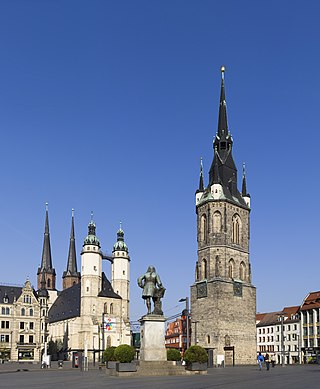
In the Battle of Halle on 17 October 1806 a French corps led by Jean-Baptiste Bernadotte fought the Prussian Reserve under Eugene Frederick Henry, Duke of Württemberg. The French defeated their opponents, forcing the Prussians to retreat northeast toward Dessau after suffering heavy losses. The clash occurred in the War of the Fourth Coalition, part of the Napoleonic Wars. The city of Halle is located about 30 kilometers northwest of Leipzig on the Saale River.
The Battle of Kaiserslautern saw an army from the Kingdom of Prussia and Electoral Saxony led by Wichard Joachim Heinrich von Möllendorf fall upon a single French Republican division under Jean-Jacques Ambert from the Army of the Moselle. The Prussians tried to surround their outnumbered adversaries but most of the French evaded capture. Nevertheless, Möllendorf's troops inflicted casualties on the French in the ratio of nine-to-one and occupied Kaiserslautern. While the Prussians won this triumph on an unimportant front, the French armies soon began winning decisive victories in Belgium and the Netherlands. The battle occurred during the War of the First Coalition, part of the French Revolutionary Wars. In 1794 Kaiserslautern was part of the Electoral Palatinate but today the city is located in the state of Rhineland-Palatinate in Germany about 67 kilometres (42 mi) west of Mannheim.

The Battle of Arnhem saw Friedrich Wilhelm Freiherr von Bülow's Prussian corps fight an Imperial French division under Henri François Marie Charpentier at Arnhem. Attacking under the cover of fog, the Prussians broke into the city at several points and forced the French to retreat to Nijmegen after hard fighting in this War of the Sixth Coalition clash. Arnhem is a city in the Netherlands located on the Rhine River 100 kilometres (62 mi) southeast of Amsterdam.

The Battle of Willems saw a Republican French army under Jean-Charles Pichegru oppose Coalition forces commanded by Prince Frederick, Duke of York and Albany, as part of a French attempt to defeat an Allied counteroffensive and continue its own 1794 offensive in the Low Countries, which had already seen success with the battle of Mouscron and the capture of the important cities of Menin and Courtrai. The battle was a French tactical defeat, but victory in the battle of Courtrai the next day, coupled with the Duke of York's realisation that he was badly outnumbered, led to Allied withdrawal and a strategic victory for the French, who retained their hold on Menin and Courtrai. During this action, French infantry formed in squares and repulsed Coalition cavalry for the first time during the war. The fighting occurred during the War of the First Coalition near Kortrijk, Belgium, located about 85 kilometres (53 mi) west of Brussels.
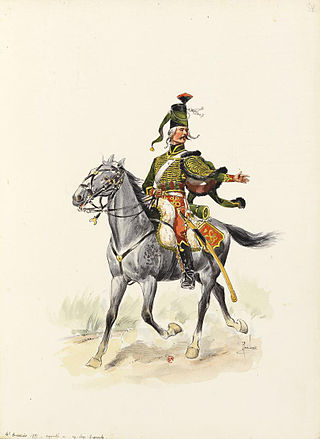
The Légion de Conflans later the Régiment de Saxe Hussards was a German-French legion formed during the War of the Austrian Succession. The legion would later serve in the Seven Years' War, but like the other French legions, legion was split and became a hussar regiment. However, following the beginning of the French Revolution, the regiment emigrated en masse and was disbanded shortly thereafter.


















